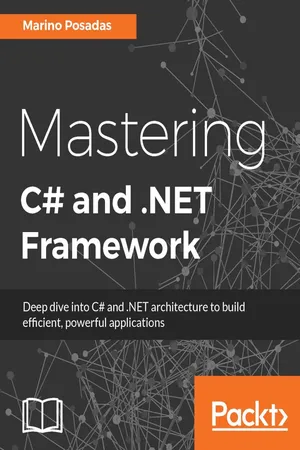
- 560 pages
- English
- ePUB (mobile friendly)
- Available on iOS & Android
Mastering C# and .NET Framework
About this book
Deep dive into C# and.NET architecture to build efficient, powerful applications
About This Book
- Uniquely structured content to help you understand what goes on under the hood of.NET's managed code platform to master.NET programming
- Deep dive into C# programming and how the code executes via the CLR
- Packed with hands-on practical examples, you'll understand how to write applications to make full use of the new features of.NET 4.6, .NET Core and C# 6/7
Who This Book Is For
This book was written exclusively for.NET developers. If you've been creating C# applications for your clients, at work or at home, this book will help you develop the skills you need to create modern, powerful, and efficient applications in C#.
No knowledge of C# 6/7 or.NET 4.6 is needed to follow along—all the latest features are included to help you start writing cross-platform applications immediately. You will need to be familiar with Visual Studio, though all the new features in Visual Studio 2015 will also be covered.
What You Will Learn
- Understand C# core concepts in depth, from sorting algorithms to the Big O notation
- Get up to speed with the latest changes in C# 6/7
- Interface SQL Server and NoSQL databases with.NET
- Apprehend SOLID principles and the most relevant GoF Patterns with practical examples in C# 6.0
- Defend C# applications against attacks
- Use Roslyn, a self-hosted framework to compile and advanced edition in both C# and Visual basic.NET languages
- Discern LINQ and associated Lambda expressions, generics, and delegates
- Design a.NET application from the ground up
- Understand the internals of a.NET assembly
- Grasp some useful advanced features in optimization and parallelism
In Detail
Mastering C# and.NET Framework will take you in to the depths of C# 6.0/7.0 and.NET 4.6, so you can understand how the platform works when it runs your code, and how you can use this knowledge to write efficient applications. Take full advantage of the new revolution in.NET development, including open source status and cross-platform capability, and get to grips with the architectural changes of CoreCLR.
Start with how the CLR executes code, and discover the niche and advanced aspects of C# programming – from delegates and generics, through to asynchronous programming. Run through new forms of type declarations and assignments, source code callers, static using syntax, auto-property initializers, dictionary initializers, null conditional operators, and many others. Then unlock the true potential of the.NET platform. Learn how to write OWASP-compliant applications, how to properly implement design patterns in C#, and how to follow the general SOLID principles and its implementations in C# code.
We finish by focusing on tips and tricks that you'll need to get the most from C# and.NET.
This book also covers.NET Core 1.1 concepts as per the latest RTM release in the last chapter.
Style and approach
This book uses hands-on practical code examples that will take you into the depths of C# and.NET. Packed with hands-on practical examples, it is great as a tutorial, or as a reference guide.
Frequently asked questions
- Essential is ideal for learners and professionals who enjoy exploring a wide range of subjects. Access the Essential Library with 800,000+ trusted titles and best-sellers across business, personal growth, and the humanities. Includes unlimited reading time and Standard Read Aloud voice.
- Complete: Perfect for advanced learners and researchers needing full, unrestricted access. Unlock 1.4M+ books across hundreds of subjects, including academic and specialized titles. The Complete Plan also includes advanced features like Premium Read Aloud and Research Assistant.
Please note we cannot support devices running on iOS 13 and Android 7 or earlier. Learn more about using the app.
Information
Mastering C# and .NET Framework
Table of Contents
Table of contents
- Mastering C# and .NET Framework